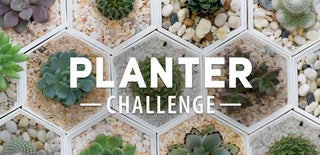Introduction: Perfect Planter - the Smartest Planter You Have Ever Seen
This planter is probably one of the smartest planters you have ever seen. All in it's sleek and modern design, this planter boasts a soil sensor that detects when your soil is dry. When it is dry, a peristaltic pump turns on and automatically waters your plants for any amount that you like. Now, that is not all. On the top and the side, there is a grow light that will be on as long as the planter is plugged into an outlet. The plug is a dc barrel jack and this project includes the specific cable. The specific cable will be mentioned later. The whole entire project was designed in Tinkercad. And, this whole project is $55.
Level: ADVANCED
Reason: Requires a lot of materials that not a lot of people have that don't have a link to buy in the parts step, such as silicone sealer, plastics bonder, and a drill with small bits. Also, It requires printed parts with different materials and an intermediate sense of soldering.
Advantages:
- Auto watering
- Grow light
- Relatively cheap
- Edible plants allowed
- Outlet controlled
Disadvantages:
- Can get very hot
- The water reservoir is tiny(10mL)
- The planting area is small, not meant for big plants
Step 1: Print the Parts!
Print the parts:
The PLA model is printed in PLA, supports enabled
The FLEX model can be printed in and flexible material, I used ninjaflex. NO supports enabled.
I used a Prusa i3 Mk2s as my printer.
Step 2: Get the Parts!
Buy these:
Power supply(THIS ONE ONLY): https://www.adafruit.com/product/276 $7.95
Tube: https://www.adafruit.com/product/3659 $3.50
USB splitter: https://www.amazon.com/Cute-USB-2-Port-Splitter-B... $9.99
Pump: https://www.amazon.com/INTLLAB-Peristaltic-Liquid...$9.80
Grow Light: https://www.amazon.com/Superdream-Waterproof-Aqua... $8.99
USB to USB Jack: https://www.amazon.com/gp/product/B00EQ1UN5G/ref=... $6.20
Arduino Nano: https://www.aliexpress.com/item/1pcs-lot-Nano-Atm... $1.99
Soil sensor: https://www.amazon.com/gp/product/B01N7NA3HP/ref=... $5.99
You will need:
Drill + drill bits
Silicone sealer
Sharp blade
Plastics bonder
Soldering iron
48.423d printer
PLA filament
FLEX filament
Total cost (not including "you will need"): $54.41
Step 3: Place the Grow Light in and Shrink Other Parts.
Take the grow light strip and line the grooves. Cut the strip where you need to turn and solder the pads to the next small strip, as shown in the picture. Then cut the grow light at the end and re-solder the USB to the end of the strip. Sounds confusing, but you basically need to shorten the strip. You might need to do this with the Arduino nano cable also. Then, use a blade to cut off the 2 ends of the pump, as shown.
Step 4: Put the Power Jack in and Start Soldering!
Put the power jack into the hole, and widen the hole if needed. Then, take a look at the schematic above. There is the Arduino, sensor, and a buzzer. Then, there is a motor controller. I soldered the motor parts onto a perf board, which is strongly recommended. I soldered the wires to everything else normally. Plug in the Arduino and upload the code. Stuff everything inside of the planter. So, after getting the parts I realized that there was a miscalculation. Instead of a rectangular prism for the planting area, the space is divided into a stairstep pattern. Cut out a length of the tube around 2" and place it in the connector of the motor. Before that, turn on the motor and figure out which side is sucking the water, and place the tube on that side. Then, take your blade and cut out the outline of the printed reservoir. Leave the bottom side so the plastic can act as a flap (The picture should explain it). Place the printed reservoir and attach the other end of the tube that you just cut to the reservoir. I used the silicone sealant and the plastic bonder to attach the reservoir to the tube.
Credit to the Adafruit Learning System for the DC Arduino Motor tutorial.
Step 5: Place in the Cover and Seal It Up
Take your tube and measure the length of the stairstep printed part and cut the tube 1/4" longer than that. Attach that to the other end of the pump and place in the stairstep printed cover part. Place the moisture sensor as low as you can put it, so you can cover it up with soil later. Then, seal the gap between the stairstep part and the planter with the silicone sealer. Cover up space by the soil sensor, the hole where the grow light goes into the planter, and the hole where the tube enters. Seal the end of the tube and drill 2 holes in the tube(I used a 1/16" bit), one in the first section, and one in the second section. (Sections are the spaces where the depth changes in the stairstep pattern.) Test it and make sure everything works.
Step 6: Place in the Soil and Plant!
You can now place in the soil and start planting. I am planting a mint plant, so you can print edibles. I used a timer to put the planter on for 4 hours. DON'T put the planter on 24/7 as it could FRY YOUR ELECTRONICS and MELT THE PLASTIC. Enjoy!

Participated in the
Planter Challenge















